Nestled within the tropical paradise of Hawaii, you’ll find a vibrant spectrum of birdlife. Among them are 8 unique species that sport brilliant shades of orange, bringing a unique twist to the island’s lush greenery and azure waters. These birds, draped in various shades of orange, make the Hawaiian islands even more enchanting.
From common backyard visitors to elusive forest dwellers, this blog post uncovers the mysteries and beauty of these captivating orange birds of Hawaii. With our free photo guide, you’ll not only learn about them, but also see their vibrant colors up close and personal.
Orange Birds Found In Hawaii
Hawaii’s diverse geography, ranging from lush rainforests and high-altitude volcanic peaks to warm, sandy beaches, provides an array of unique habitats that support a wide variety of bird species, including those with vibrant orange plumage.
Iiwi


| Feature | Measurement |
|---|---|
| Scientific Name | Drepanis coccinea |
| Length | 5.9–6.3 in |
| Wingspan | 8.9–9.1 in |
| Weight | 0.8–0.9 oz |
The Iiwi, also known as the Scarlet Honeycreeper, is an iconic and brightly colored bird native to Hawaii.
Appearance: The Iiwi stands out with its brilliant scarlet plumage, contrasting sharply with its black wings and tail. One of its most distinguishing features is its long, curved, salmon-colored bill.
Diet: As a honeycreeper, the Iiwi primarily feeds on nectar from various native Hawaiian flowers. However, they also consume insects and spiders, especially when feeding their young.
Reproduction: Iiwi build small, cup-shaped nests made from twigs, ferns, and mosses, usually situated in the canopy of ohia-lehua trees. The female lays a clutch of two to three pale blue or white eggs. Both parents take turns feeding the chicks.
Apapane
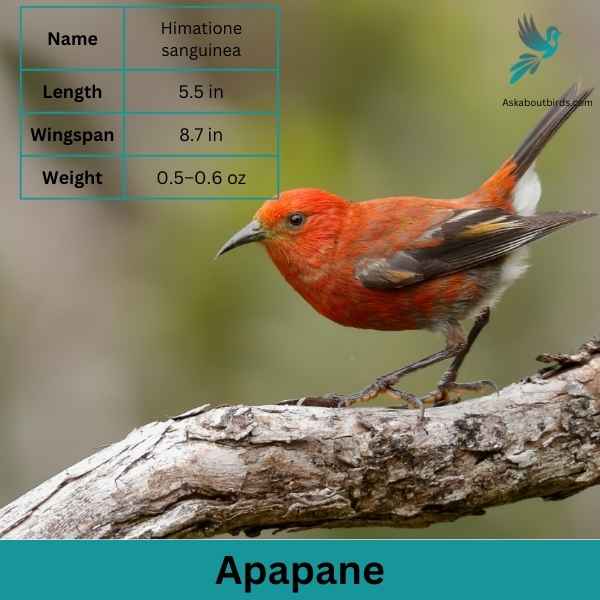

| Feature | Measurement |
|---|---|
| Scientific Name | Himatione sanguinea |
| Length | 5.5 in |
| Wingspan | 8.7 in |
| Weight | 0.5–0.6 oz |
The Apapane is a striking Hawaiian honeycreeper known for its vibrant red plumage and dynamic vocalizations.
Appearance: Predominantly scarlet in color, the Apapane has contrasting black wings and tail. It’s easily identified by its white undertail coverts and slightly curved black bill.
Diet: The Apapane’s diet is primarily nectar-based, with the bird showing a preference for the blossoms of the ohia-lehua tree. Occasionally, they also feed on insects and spiders.
Reproduction: Apapane build their nests in native trees, especially in ohia forests. The nest is a small, neat cup made of mosses, lichens, and small plant fibers. The female typically lays a clutch of two to three eggs, which are pale blue-green in color. Both parents partake in feeding the fledglings.
Red-Crested Cardinal
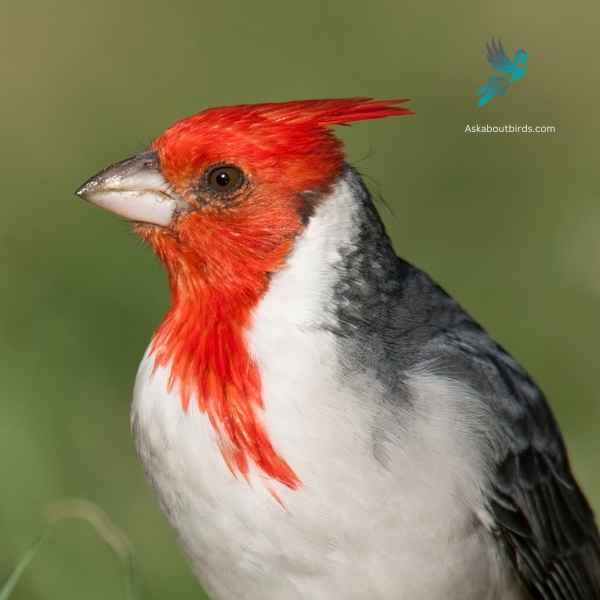
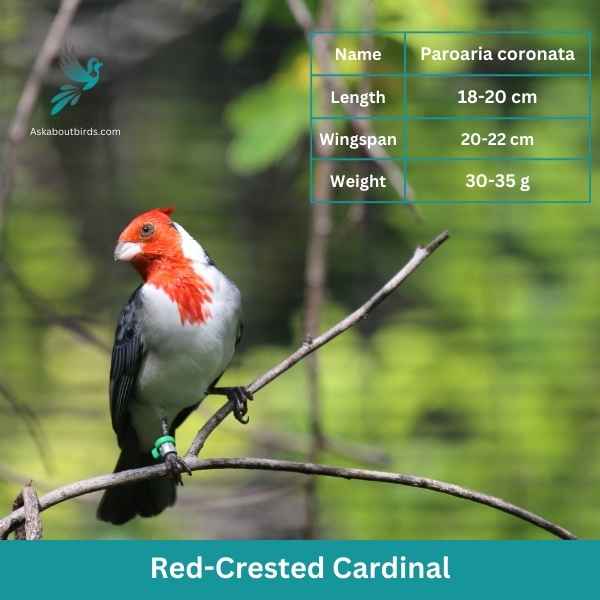
| Feature | Measurement |
|---|---|
| Scientific Name | Paroaria coronata |
| Length | 18-20 cm |
| Wingspan | 20-22 cm |
| Weight | 30-35 g |
The Red-Crested Cardinal is a visually striking bird native to South America, particularly found in countries like Brazil and Argentina. It is named for its vibrant red crest, which stands tall atop its head, contrasting with its grayish body and wings. Both males and females share this distinctive feature, with males having more pronounced red coloration.
These cardinals are typically found in open habitats such as grasslands, savannas, and gardens. They have adapted well to human-altered landscapes. Red-Crested Cardinals are omnivorous, feeding on a diverse diet that includes seeds, fruits, insects, and even small vertebrates. They use their powerful beaks to crack open seeds and capture prey.
Akohekohe


| Feature | Measurement |
|---|---|
| Scientific Name | Palmeria dolei |
| Length | 6.7 inches |
| Wingspan | 11 inches |
| Weight | 1.0–1.2 oz |
The Akohekohe, also known as the Crested Honeycreeper, is a distinctive bird native to the islands of Hawaii.
Appearance: The Akohekohe stands out due to its vivid plumage. It has a mostly black body with white feather tips and a large white crest on its forehead. The bird’s bright orange bill and legs add to its striking appearance.
Diet: The Akohekohe primarily feeds on nectar from native plants. It uses its curved beak to reach into flowers, but it will also eat insects and spiders.
Reproduction: Breeding season for the Akohekohe occurs from January to June. They typically build their nests in ohia trees and the female will lay 1-2 eggs. The female takes the lead in incubating the eggs and caring for the young, with some help from the male.
Palila

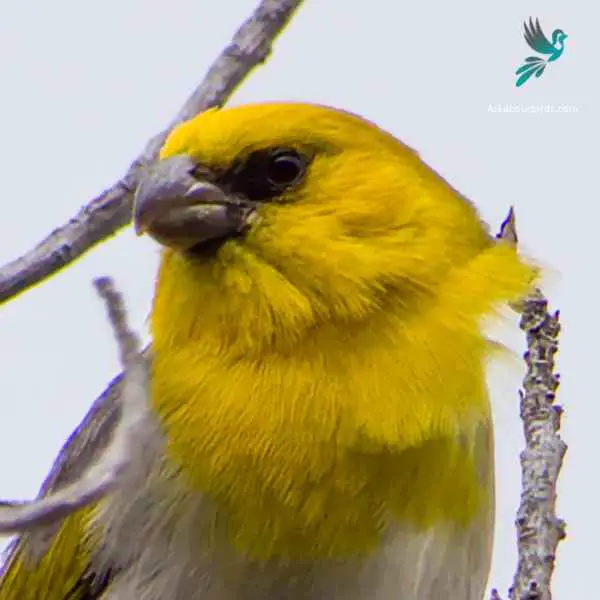
| Feature | Measurement |
|---|---|
| Scientific Name | Loxioides bailleui |
| Length | 7.5 in |
| Wingspan | 10.2 in |
| Weight | 1.4–1.6 oz |
The Palila, an iconic bird of Hawaii, is known for its specialized feeding habits and the distinctive coloration of its plumage.
Appearance: The Palila has a striking color contrast, with a light gray body, a yellow head and neck, and a white belly. Its beak is robust and large, well-adapted for its feeding habits. This bird’s wings and tail are dark gray to black, adding to the visual contrast.
Diet: Palilas have a unique diet mostly consisting of the immature seeds of the māmane tree. The birds also eat the tree’s flowers, buds, and insects, particularly caterpillars and beetle larvae. This dietary preference makes the Palila an important seed disperser in its ecosystem.
Reproduction: Palilas are monogamous birds, and they breed between February and September. They usually build their nests in māmane trees, laying a clutch of 2-3 eggs.
Iiwi


| Feature | Measurement |
|---|---|
| Scientific Name | Drepanis coccinea |
| Length | 5.9–6.3 in |
| Wingspan | 8.9–9.1 in |
| Weight | 0.8–0.9 oz |
The Iiwi, also known as the Scarlet Honeycreeper, is an iconic and brightly colored bird native to Hawaii.
Appearance: The Iiwi stands out with its brilliant scarlet plumage, contrasting sharply with its black wings and tail. One of its most distinguishing features is its long, curved, salmon-colored bill.
Diet: As a honeycreeper, the Iiwi primarily feeds on nectar from various native Hawaiian flowers. However, they also consume insects and spiders, especially when feeding their young.
Reproduction: Iiwi build small, cup-shaped nests made from twigs, ferns, and mosses, usually situated in the canopy of ohia-lehua trees. The female lays a clutch of two to three pale blue or white eggs. Both parents take turns feeding the chicks.
Oahu Elepaio


| Feature | Measurement |
|---|---|
| Scientific Name | Chasiempis ibidis |
| Length | 5.5 in |
| Wingspan | 7.5 in |
| Weight | 0.7 oz |
The Oahu Elepaio, a member of the monarch flycatcher family, is an agile bird known for its distinctive song and cheerful demeanor.
Appearance: The Oahu Elepaio sports a brown upper body with a grayish-white belly. It has a prominent black mask that extends through the eyes and a fan-shaped tail often held in an upright position.
Diet: The Oahu Elepaio is an insectivore, feeding on a wide variety of insects and spiders. It is an active hunter, often seen flitting through low vegetation and along tree trunks.
Reproduction: The breeding season for the Oahu Elepaio is from January through July. The female constructs a cup-shaped nest in a tree or shrub, where she lays a clutch of 1-3 eggs. Both parents share in incubation duties and feeding the hatchlings.
Kauai Elepaio
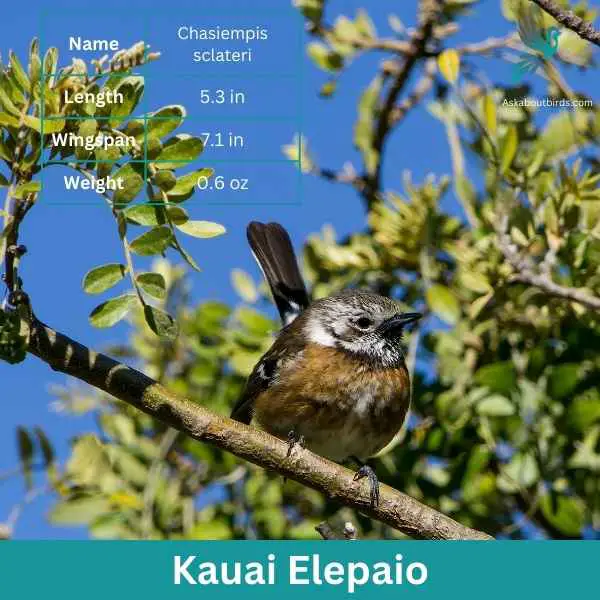

| Feature | Measurement |
|---|---|
| Scientific Name | Chasiempis sclateri |
| Length | 5.3 inches |
| Wingspan | 7.1 inches |
| Weight | 0.6 oz |
The Kauai Elepaio is a native monarch flycatcher confined to the island of Kauai in Hawaii. It is known for its nimbleness and holds cultural significance in Hawaiian traditions.
Appearance: This petite bird has a noticeable contrast between its white underbelly and chestnut-brown upperparts. The face features a prominent white eyebrow, which stands out against a darker cap. Its long tail, often splayed out, has white tips that are conspicuous against the rest of its plumage.
Diet: Feeding predominantly on insects, the Kauai Elepaio agilely navigates the foliage, sometimes even hovering, to capture beetles, spiders, and other small prey.
Reproduction: The nests of the Kauai Elepaio, often cup-shaped and intricately woven with moss, lichen, and spider webs, are placed either on tree branches or occasionally on the ground. Typically, two to three eggs, white with brownish spots, are laid.
Hawaii Elepaio
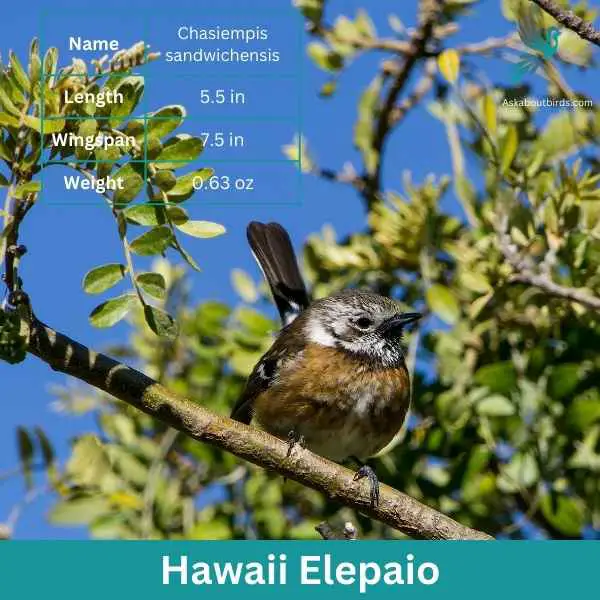

| Feature | Measurement |
|---|---|
| Scientific Name | Chasiempis sandwichensis |
| Length | 5.5 inches |
| Wingspan | 7.5 inches |
| Weight | 0.63 oz |
The Hawaii Elepaio is a distinct monarch flycatcher endemic to the Big Island of Hawaii. This agile bird has a unique presence in the dense forests, adding a spark of energy and life to its surroundings.
Appearance: The Hawaii Elepaio sports a contrasting palette of colors with its white underparts set against chestnut-brown upperparts. It possesses a white eyebrow stripe that’s set off by a darker crown. The bird’s tail is relatively long with characteristic white tips, which provide an added touch to its elegant appearance.
Diet: Primarily insectivorous, the Hawaii Elepaio is an adept hunter, skillfully maneuvering through tree branches to catch beetles, spiders, and other small invertebrates.
Reproduction: The bird constructs a meticulous nest, often cup-shaped, using materials like moss, lichen, and spider webs. Located on tree branches or sometimes the ground, the nest shelters two to three white eggs speckled with brown spots. Both parents participate in incubation and play a role in raising the chicks once they hatch.
Where to Spot Hawaii’s Orange Birds
Hawaii, a tropical paradise renowned for its stunning beaches, towering volcanoes, and vibrant biodiversity, is also a hub for avian enthusiasts. The diverse habitats across the islands host a variety of fascinating bird species, making it a premier destination for birdwatching. Here are some of the best locations in Hawaii to witness the colorful spectacle of birdlife:
- Haleakala National Park, Maui: The rugged landscapes and diverse ecosystems of Haleakala offer an extraordinary array of bird species. The park’s native shrubland is particularly known for hosting the striking ‘I’iwi and the endemic Maui Parrotbill.
- Hawaii Volcanoes National Park, Big Island: Here, amidst stunning volcanic landscapes, one might catch a glimpse of the vibrant ‘Apapane and the rare Palila. This park also offers guided bird walks, providing visitors an immersive birding experience.
- Kilauea Point National Wildlife Refuge, Kauai: This coastal sanctuary provides panoramic ocean views and opportunities to spot seabirds. Besides, you can watch the native Kauai Elepaio flitting around the vegetation.
- Kealia Pond National Wildlife Refuge, Maui: With over 200 acres of wetlands, this refuge attracts numerous waterfowl and migratory birds. Its extensive boardwalk makes bird viewing accessible and enjoyable.
- Waimea Valley, Oahu: Nestled in the heart of Oahu, this lush botanical garden is home to various Hawaiian birds, including the Oahu Elepaio and many migratory species.
Hawaii does not have any neighboring states due to its unique geographic location in the middle of the Pacific Ocean. However, I can provide you with a table of the closest states to Hawaii, as mentioned, California, Oregon, and Washington, along with bird watching spots in each.
| State’s Orange birds | Best Spot |
|---|---|
| Oregon’s Orange Birds | Malheur National Wildlife Refuge, Mount Hood National Forest, Yaquina Head Outstanding Natural Area |
| California’s Orange Birds | Point Reyes National Seashore, Farallon Islands, Monterey Bay |
| Washington’s Orange Birds | Olympic National Park, Nisqually National Wildlife Refuge, Ridgefield National Wildlife Refuge |
FAQs on Orange Bird Species Found in Hawaii
What is the orange chest bird in Hawaii?
The Red-crested Cardinal, with its striking appearance and bright red chest, is one of the birds that can be seen in Hawaii. However, it’s worth noting that the Red-crested Cardinal is not a native species but was introduced to Hawaii. They are commonly seen around bird feeders and are easily recognized among other wild birds.
What is the yellow orange bird in Hawaii?
The saffron finch, known for its yellow-green plumage and its characteristic hue that leans between yellow and orange, is the bird that comes to mind. Although they originate from South America, these medium-sized birds have been introduced to Hawaii and can be found around bird feeders.
Are saffron finches native to Hawaii?
No, saffron finches are not native to Hawaii. They originally hail from South America. Over time, they were introduced to Hawaii and, like several other bird species, have established a presence in the region. While they add to the diversity of bird sightings, it’s essential to understand the implications of invasive species on native birds.
Is a saffron finch a finch?
Yes, the saffron finch is indeed a finch. It is a medium-sized bird known for its bright yellow-green plumage. In their natural habitat in South America, they are commonly found in open and semi-open areas. In Hawaii, they can be seen among other introduced and native species around bird feeders and in the wild.
In Hawaii, the vibrant colors of the avian world often leave onlookers in awe. While the islands are home to a myriad of native species, introduced birds have also found a haven here. Among these, the Red-crested Cardinal, originally a forest bird from South America, stands out with its striking appearance. Although not a native species, they have become common backyard birds on the major Hawaiian islands, often seen flitting around bird feeders.
The saffron finch, with its yellow-green plumage, is another bird introduced to Hawaii. Native to South America, this medium-sized bird can now be seen foraging for grass seeds alongside the spotted dove and the Zebra dove.
House finches, particularly the house finch male with their distinctive red hues, originated from Western North America and have also become part of Hawaii’s bird mosaic. However, not all introduced birds have harmonious coexistence with native birds. Species like the Red-vented Bulbul have gained a reputation as an agricultural pest, posing threats to native species by competing for food and occupying other birds’ nests.
Moreover, while wild chickens and the Hawaiian owl a brown bird , or ‘Pueo’, hold cultural significance, other bird species, such as the rose-ringed parakeet and the Northern Cardinal, brought from other islands, continue to reshape Hawaii’s avian landscape. It’s crucial to strike a balance to ensure the survival and thriving of both native and introduced species.





